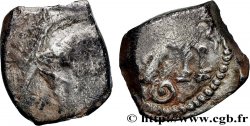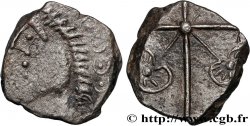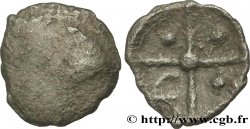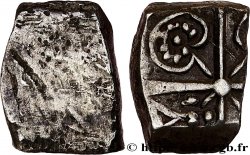v43_1131 - GALLIEN - SÜDWESTGALLIEN - RUTENI (Region die Rodez) Drachme “au sanglier”, à la grosse tête bouclée, S. 440
MONNAIES 43 (2010)
Startpreis : 320.00 €
Schätzung : 500.00 €
Erzielter Preis : 350.00 €
Anzahl der Gebote : 2
Höchstgebot : 350.00 €
Startpreis : 320.00 €
Schätzung : 500.00 €
Erzielter Preis : 350.00 €
Anzahl der Gebote : 2
Höchstgebot : 350.00 €
Type : Drachme “au sanglier”, à la grosse tête bouclée, S. 440
Datum: IIe-Ier siècle av. J.-C
Metall : Silber
Durchmesser : 15,00 mm
Stempelstellung : 9 h.
Gewicht : 2,22 g.
Seltenheitsgrad : R2
Kommentare zum Erhaltungszustand:
Droit complet et d’un très beau style, mais revers avec la tête du sanglier hors flan. Très belle patine grise, avec des nuances ocres orangées
N° im Nachschlagewerk :
Pedigree :
Cet exemplaire provient du stock BOURGEY
Vorderseite
Titulatur der Vorderseite ANÉPIGRAPHE.
Beschreibung Vorderseite Grosse tête à gauche, la chevelure faite d'une rangée de petites boucles en esses sous une rangée de boucles rondes ; quatre points marquent le bout du nez, la bouche et le menton ; cou orné d'un collier perlé sur deux ou trois autres colliers unis ; le tout dans un grènetis.
Rückseite
Titulatur der Rückseite ANÉPIGRAPHE.
Beschreibung Rückseite Sanglier à gauche entre deux annelets bouletés ; le tout dans un grènetis.
Kommentare
Toutes les monnaies du type Savès n° 440, avec la grosse tête, semblent ne sortir que d'un seul coin de droit, si caractéristique avec les deux petits globules à la base du cou (et peut-être d'un seul coin de revers). Très bel exemplaire pour cette série dont les spécimens sont très souvent mal frappés et exceptionnellement bien centrés.
All coins of the Savès type No. 440, with the large head, seem to come from only one obverse die, so characteristic with the two small globules at the base of the neck (and perhaps from a single reverse die). A very fine example for this series, the specimens of which are very often poorly struck and exceptionally well centered.
All coins of the Savès type No. 440, with the large head, seem to come from only one obverse die, so characteristic with the two small globules at the base of the neck (and perhaps from a single reverse die). A very fine example for this series, the specimens of which are very often poorly struck and exceptionally well centered.








 Berichten über einen Fehler
Berichten über einen Fehler Die Seite drucken
Die Seite drucken Teilen meiner Auswahl
Teilen meiner Auswahl Stellen Sie eine Frage
Stellen Sie eine Frage Einlieferung/Verkauf
Einlieferung/Verkauf
 Details
Details










